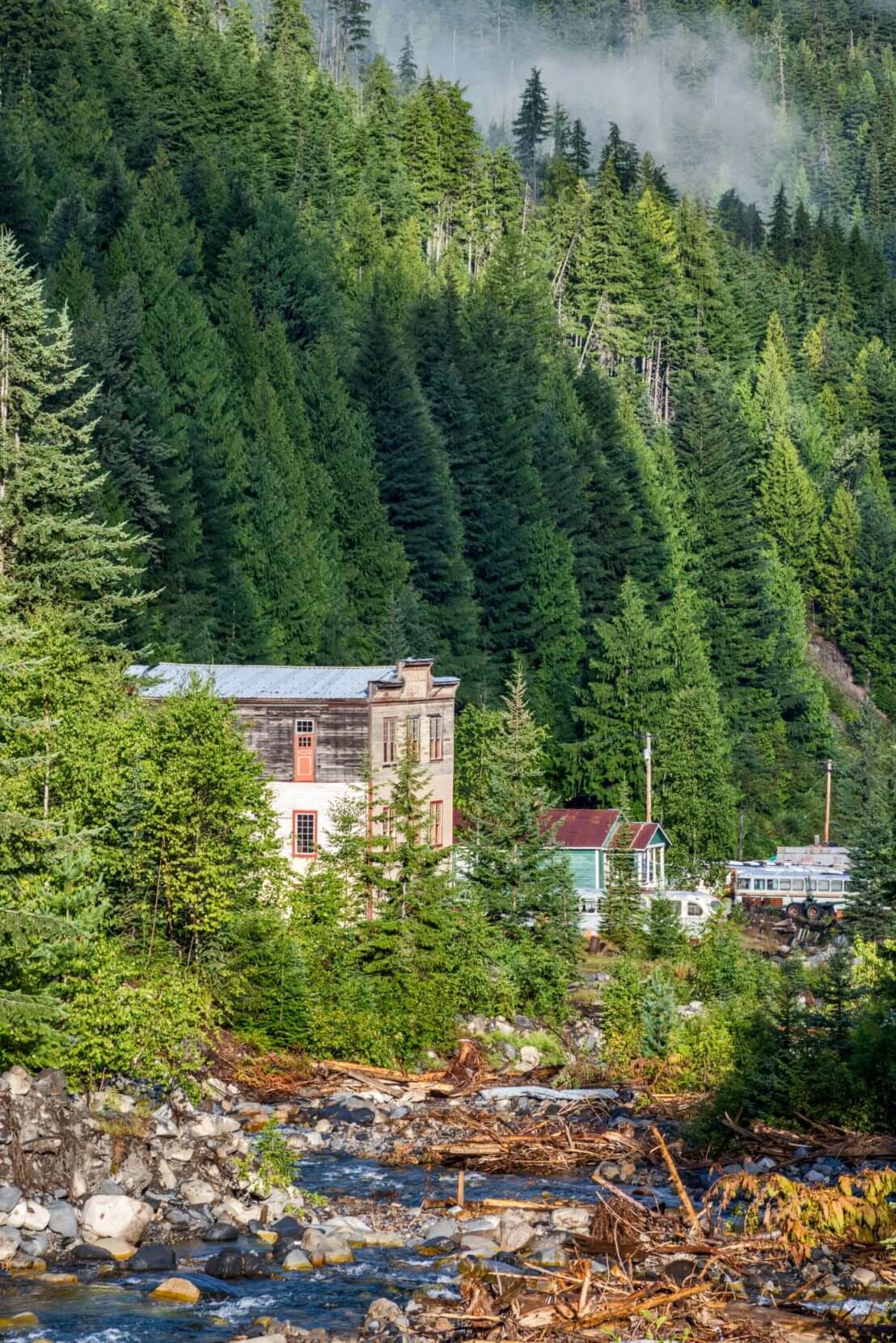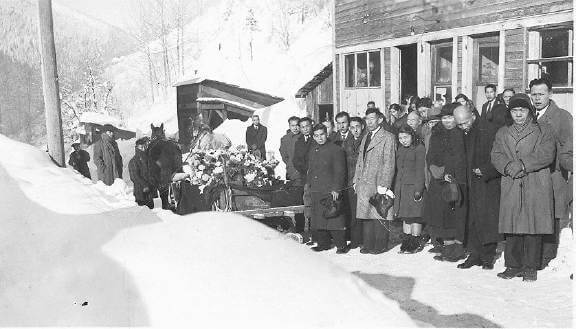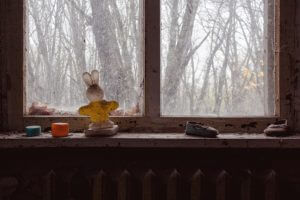Support Hidden Compass
Our articles are crafted by humans (not generative AI). Support Team Human with a contribution!
The road is rutted. The gravel, loose. Our tires pitch over fragments of rock sharp enough to puncture, and long-dead tree branches, bleached deeply by time and the elements. I think of bones crunching under our wheels, and then turn to something else, for fear that I will succumb to the motion sickness I have been pushing down along this wild and winding path.
When it emerges, it looks like a Hollywood set: Perfectly weathered wooden clapboard buildings slouch along a pocked dirt road; their hanging signs announce a forgotten purpose as they sway in the mountain breeze. Deep in British Columbia’s isolated Slocan Valley, the abandoned silver mining town of Sandon has stories to tell — some that we speak of, and others that exist in the shadows.
We get out of the car, the Valhalla mountains towering on one side of our SUV and a precipice leading steeply down to Slocan Lake on the other. This place looks like it should have always been wild, populated by bears, and eagles, and conifers, but evidence of people — of industry and wealth acquired and lost — is all around. Jarring. Incongruous. Exhilarating.
I quickly survey the town, wishing for a guide — someone to whisper Sandon’s secrets in my ear, but it’s not difficult to summon ghosts here. And they are as good a guide as any. There are plenty to take me back in time: miners, pioneers, and those whom history has largely forgotten.
~~
Our visit to the Kootenay region had been one of monumental beauty that overwhelmed my senses, especially my sense of adventure. There were glacial lakes flanked by forests, valleys flanked by mountains, and roads flanked by stands of deer — which seemed less impressed by the sight of me than I was by them. But I am not an instinctively outdoorsy person, and as awed as I was by this wild, wild country, I’d been longing for something else. I came here to glimpse the West — not the one that exists today, but the one that inspired foolhardy frontiersmen and women to trek to an unwelcoming valley in search of silver and glory. The West that boomed, then busted, leaving shards of rock blasted from the mountainside and the shells of buildings too stubborn to fall — bits of infrastructure whose design ingenuity only adds to the tragic romanticism of a failed experiment. Leaving ghosts.
Tucked away in a narrow valley between Slocan and Kootenay Lakes, Sandon is that Wild West fever dream.

The discovery of galena ore in Carpenter Creek kicked of Sandon’s silver boom, which employed thousands. PHOTO: WITOLD SKRYPCZAK / ALAMY
~~
When Eli Carpenter and John Sandon discovered galena ore — an important source of silver and lead — in Carpenter Creek in 1891, they set off a mining boom that produced more mineral in value than Canada’s Klondike Gold Rush. At its peak, remote and cloistered Sandon had nearly 300 mines in operation. There, 2,300 miners worked the claims and even more non-miners populated the town. By the start of the 20th century, Sandon was truly booming. With a fire department, a school, a hospital, a city council building, shops, two newspapers, opera houses, and electricity, miners could bring their families to Sandon and see them live a fairly comfortable life.
But the air of civilized society butted sharply against the other realities of life in a mining town: Most of the miners were not, in fact, family men. And the beautifully board-walked streets and flumed creeks led the miners just as purposefully to dozens of brothels, saloons, and hotels as they did to the new Methodist church.
There were no men or women of weak disposition in such a place, and it was the remnants of this grit, proof of this temerity, that I searched for as I reverently walked the streets of the lovingly preserved and restored town. I found it on the steps leading to a miner’s meagre shack; in the artifacts displayed in the museum’s rustic exhibits; throughout the streets that had seen floods and fires, triumph and tragedy.
I looked at photos of hardworking men felling logs, and Reco Avenue stretching along the valley’s muddy floor. I stopped to take in an image of the bright white of the completed, snow-covered street in stark relief against the black profile of the mountains closing in on it. These pictures — these artifacts — were proof of the ghosts we know. But what about the others? What happened between then and now? Who else had been here? The mines may have ceased production, but as eager as the forest and mountains are to reclaim anything within their reach, they never fully reclaimed Sandon.
~~
Twenty-two years after Sandon’s silver veins ran dry and the town officially unincorporated, there was a dark resurrection. In 1942, in the wake of Japan’s attack on Pearl Harbor, the Canadian government under Prime Minister William Lyon Mackenzie King passed legislation allowing the removal of any persons from areas considered vulnerable to attack. Under the protection of these loose guidelines and fueled by simmering racism against the Japanese population, the province forced more than 22,000 Japanese Canadians to relocate from the coast to farms and internment camps first to the BC interior, then to points much farther east from home.
It’s not difficult to summon ghosts here… miners, pioneers, and those whom history has largely forgotten.
Tom Tamagi, was 22 years old when he was given 24-hours warning before being taken to a Hastings Park holding area, “A prisoner of my own country of birth.”
“Of all the god-forsaken places to be interned,” wrote Michael Kluckner in his book, “Vanishing British Columbia,” “there was Sandon.”
The town founded on the dogged pursuit of freedom, prosperity, and pleasure, became a prison to 950 Japanese Canadians. Stripped of the businesses they had built and forced from the fishing industry in which they thrived, the families in Sandon, one of eight such camps in the Slocan region, were given insufficient rations and pressed to eke out an existence through irregular work on nearby farms and construction projects.
The infrastructure so impressively established at the turn of the century turned out to be desperately inadequate to support an involuntary community 50 years later.
Heating, indoor plumbing, and food were scarce in the overcrowded camp where a dilapidated 14’x28’ shack with no running water would be home to two families. More living space could be dug out of the earthen floor, or green, damp wood might be allotted for additional lean-tos. Petitions were made to deliver more stoves for heat and cooking, and to allow additional vegetable gardens to be cultivated, but permits could take years. The struggles weren’t just about the practicalities of life either. All of the camp’s residents were Buddhist, but initially, Catholic nuns were brought in to teach the children. It took time, but eventually the internees succeeded in establishing schools of their own and even building a Buddhist temple.
In a photo housed in The University of British Columbia’s Library of Open Collections, a Buddhist kindergarten class poses for an unseen photographer. Forty-five tiny boys and girls, all of them in identical short haircuts, are sitting on the steps of a building flanked by two women. Nobody is smiling.
~~
But beyond the crumbling infrastructure, Sandon was harsh. Temperatures plunged well below -20 degrees Fahrenheit, and deep snow encircled the town, routinely cutting off access and leaving the area terrifyingly remote. Sandon was not a place people happened upon. It was almost impossible to find it and, therefore, it was almost impossible for anyone to find the internees once they’d been transported there. For the Canadian government, the isolation was an efficient, economic benefit. They assigned only one policeman to the entire camp.
“Now, if you’d locked up a thousand Irishmen up there, you’d need 2,000 cops to ride herd on them!” that one officer would cavalierly joke in later years.
~~
Kyujiro Domai was 61-years-old when he was interned in Sandon. A successful fisherman, he’d lived in Canada for more than 40 years and had been a naturalized citizen for nearly as long, but citizenship meant nothing in wartime, and his boat was taken away from him. Perhaps, as was true for others, his fishing trawler — his home and livelihood — was sold to help pay for the internment. Regardless, “It was a terrible shock for him to be taken away from the coast and interned in the ghost town of Sandon, B.C.,” wrote Diana Domai, the wife of Kyujiro’s grandson, in a note to author Michael Kluckner.
Kyujiro died of rheumatic fever shortly after arriving in Sandon. But according to Diana, his daughter always said that he died of a broken heart.

At the funeral of Kyujiro Domai, a successful fisherman from Stevetson, who died in Sandon at age 61 after everything was taken from him during the internment. PHOTO COURTESY OF DIANA DOMAI AND MICHAEL KLUCKNER VIA ‘VANISHING BRITISH COLUMBIA’
~~
Past the mercantile block, with its restored general store, archive rooms, and the row of trolley buses saved from a Vancouver scrap yard and now inexplicably parked downtown, I follow my ghosts to the town’s border and the jewel in Sandon’s crown: The Silversmith Power & Light Corporation, British Columbia’s first hydropower station. Completed in 1897, it still provides electricity for all of Sandon’s in-use buildings before depositing the surplus energy back into the power grid — today, Sandon’s only source of regular income. A proud testament to 19th-century engineering, its cogs, wheels, belts, and valves operate at an imposing speed and volume.
It is a marvel of modernity in a place that relies on the public’s fascination with history, but its enduring survival rests solely in the hands of the interned Japanese Canadians, who, with their forced arrival, taxed the old and neglected power station. And it is their labor, pitifully compensated, that also expanded, repaired, and future-proofed the plant. An article on the Sandon Historical Society webpage suggests that early Sandon developer J.M. Harris was delighted to see the work done, and to see his city, “bustling with hundreds of people” once again.
[In] the smoldering embers of history’s memory… is the story of a town built on the dreams of one generation, but resurrected on the nightmares of another.
From clapboard buildings that housed saloons to miner’s shacks of log and mud, Sandon’s place in the Wild West’s legacy — with its frenzied rush for fortune and glory — permeates the air like smoke from a campfire. But follow that smoke through the years to the smoldering embers of history’s memory, and you find a different story being told in the ashes. It is the story of a town built on the dreams of one generation, but resurrected on the nightmares of another.
Sandon was the first internment camp to be shut down, its inhabitants were relocated in the mid-1940s to a larger camp in New Denver.
The town proved even too remote for a prison.
~~
Driven by tourism, Sandon’s second resurrection began in the early 1990s, and is ongoing today. But tucked next to a fast-flowing creek fed by the mountains that seem almost to entomb the town, it is hard to know how long this third boom will last. Just as the structures along Reco Avenue sit in a gap-toothed line where snow or neglect or fire or flood or time have brought down the buildings, Sandon’s history is told in gap-toothed recollection.
The easy stories are recalled, romanticized, and sold to tourists in glossy-covered pamphlets and replica silver coins. But other stories, the more difficult stories, live in the ashes under burning campfires; in the whispers from the ghosts that are conjured out of shadows; and in the empty lot where a Buddhist temple once stood, until it collapsed under the winter’s heavy snow.
Cover Image: Claude Robidoux/Alamy
Karen Green
Karen Green is a writer, mother, feminist, Canuck, and always up for a new journey and a hot coffee.



